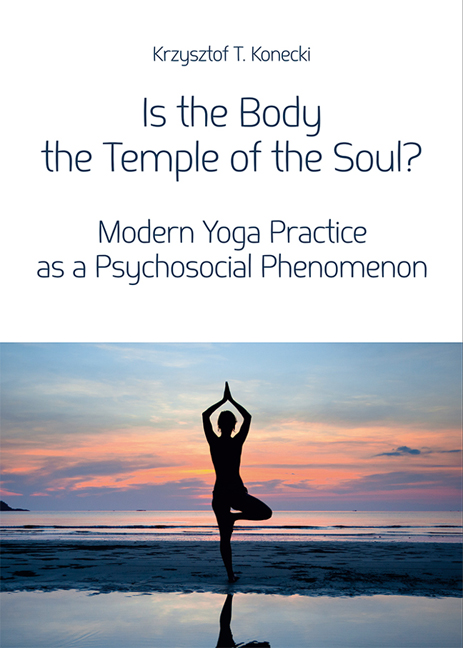Book contents
- Frontmatter
- Contents
- Foreword (Michał Szczepanik)
- Introduction
- Chapter 1 Philosophy and hatha-yoga practice. Para-religious aspects of hatha-yoga
- Chapter 2 The social world of yoga practice
- Chapter 3 Commonsense definitions of yoga and its meaning for practitioners
- Chapter 4 The process of becoming a hatha-yoga practitioner
- Chapter 5 Visual transmission of knowledge and the meaning of corporality and gestures in the social world of yoga practice
- Chapter 6 Emotions and yoga practicing. Working on emotions and achieving “emotional culture” without emotions
- Chapter 7 Teacher and guru in hatha-yoga practice
- Conclusions
- Bibliography
Chapter 5 - Visual transmission of knowledge and the meaning of corporality and gestures in the social world of yoga practice
Published online by Cambridge University Press: 10 January 2018
- Frontmatter
- Contents
- Foreword (Michał Szczepanik)
- Introduction
- Chapter 1 Philosophy and hatha-yoga practice. Para-religious aspects of hatha-yoga
- Chapter 2 The social world of yoga practice
- Chapter 3 Commonsense definitions of yoga and its meaning for practitioners
- Chapter 4 The process of becoming a hatha-yoga practitioner
- Chapter 5 Visual transmission of knowledge and the meaning of corporality and gestures in the social world of yoga practice
- Chapter 6 Emotions and yoga practicing. Working on emotions and achieving “emotional culture” without emotions
- Chapter 7 Teacher and guru in hatha-yoga practice
- Conclusions
- Bibliography
Summary
Introduction
In the chapter I deal with research problems connected with the issues of the transfer of body feelings and phenomena connected with embodiment.
The problem of the body and the embodiment became very popular in sociology since the 1990s. However, the research on the embodiment and the body have a rather theoretical character, and even if empirical, then by the use of techniques based in direct and indirect communication. Observational techniques are seldom used (see: Waskul, Vanini 2006; Jakubowska 2009). This chapter shows the trial of linking the observational techniques with the interview techniques and is close to the naturalistic research on the practice of using the body (Schubert 2006; see also Laurier, Maze, Lundin 2006; Heath, Luft, 2007a; 2007b; Konecki 2008; Knoblauch 2008), although it widens it by individual experiences of the body researched with the usage of interview techniques which characterize the approach of symbolic interactionism (Schrock, Boyd 2006) or phenomenology (Brandt 2006) or the model of research through mutual experiences (Wyka 1993). The photographic representation of many activities are common in contemporary society where the visualization of many social processes, selves and everyday life activities (e.g. hobbies, sport activities) are presented in social media and in many public places (Bogunia-Borowska, Sztompka 2012; Sztompka 2005; Drozdowski 2008; Drozdowski, Krajewski 2008).
A very important element in popularization of hatha-yoga in the modern world was the technical possibility of visual reproduction of yoga and yoga training. The development of photography, relatively low price of photography, and the possibility to print it in yoga textbooks and popular magazines are an important technological element contributing to the social development of the yoga world in the modern civilization. The transmission of yoga is currently based on “photographic realism” which causes lessening of the interest in aspects of “traditional” esoteric yoga.
Singleton (2010a: 164) quoting the views of John Putz from the work Photography and the Body shows what photography was for the modernistically oriented worldview.
- Type
- Chapter
- Information
- Is the Body the Temple of the Soul?Modern Yoga Practice as a Psychosocial Phenomenon, pp. 141 - 176Publisher: Jagiellonian University PressPrint publication year: 2016



